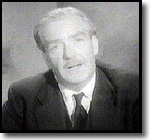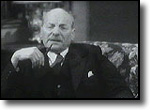
|
26 May 1955Sir Anthony Eden succeeded Winston Churchill as Conservative leader and took the Tories to their second successive election victory. The Labour Party, still under the leadership of Clement Attlee, was unable to overcome its divisions and offer the electorate a viable alternative to the Conservatives.
Background
Eden had plenty of reasons to be optimistic. Under Churchill, the Tory government of the previous four years had enjoyed quiet success. Wartime rationing was over, the Government's house building programme was running ahead of target, the Chancellor, Rab Butler, had just passed a tax cutting budget and the Labour Party was in disarray. The national mood was also upbeat. Queen Elizabeth's coronation in 1953 had proved extremely popular and Britain was basking in the success of Roger Bannister, who became the first man to run the four minute mile. Sir Edmund Hillary's conquest of Everest and England's cricketing victory over Australia in the Ashes were both still fresh in the public mind. On the international stage, the Korean War was over and Stalin's death in 1953 resulted in the easing of cold war tensions. Opinion polls showed the Government running four per cent ahead of the opposition.
Labour's manifesto, Forward with Labour, promised little except the abolition of the 11-plus exam and the restoration of the NHS to a free service, repealing Conservative charges for dental care. Attlee, the Labour leader, was visibly ageing and the Labour Party as a whole lacked direction after the implementation of most of its key policies, such as the introduction of a free health service and the nationalisation of key industries between 1945-1951. The party was also split. Nye Bevan, who resigned as Labour Minister for Health in 1951, had the party's whip withdrawn in April and was later nearly expelled from the party itself.
Sir Anthony Eden, the new prime minister, also posed a problem for Labour. They were unsure as to how to attack him. Emanuel Shinwell remarked, "At the last general election we had to fight Churchill. That was something to get our teeth into. But this time we are fighting Snow White and the Seven Dwarfs". The Liberals had a very quiet campaign. Due to a lack of funds, they were only able to contest 110 seats and as such had little impact on the direction of the campaign itself. A newspaper strike at the beginning of the campaign further contributed to the general election of 1955 being one of the quietest in post-war history.
The Result
When the results emerged, it quickly became clear that the low turnout had helped the Conservatives and Eden had been returned with an increased majority. For the first time since the nineteenth century, a party already in power had increased its representation in Parliament.
The Conservatives won 344 seats to Labour's 277, the Liberals holding only six. Turnout dropped from the 82% registered in 1951 to 76% and the Government now had a majority of 58 seats.
The two most notable casualties of the Labour defeat were Michael Foot and Woodrow Wyatt. The former Prime Minister Clement Attlee left the House of Commons for the Lords. Overall there was a 1.6% swing to the Tories. Nationalist parties, particularly Sinn Fein in Northern Ireland, increased their share of the vote.
Although this was the first election in which television played a role it had little effect on the eventual outcome. The Government benefited from
a background of peace and prosperity. The people saw the Conservatives as leading them towards a brighter future.
|
Diana, Princess of Wales, 1961-1997
Conference 97
Devolution
The Archive
News |
Issues |
Background |
Parties |
Analysis |
TV/Radio/Web
Interactive |
Forum |
Live |
About This Site
News |
Issues |
Background |
Parties |
Analysis |
TV/Radio/Web
Interactive |
Forum |
Live |
About This Site
© BBC 1997 |
politics97@bbc.co.uk |

